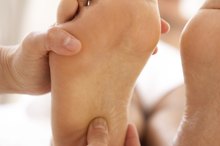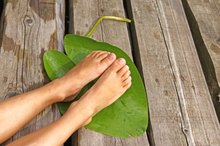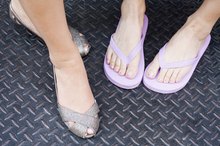Tips for Relieving MTP Joint Pain
According to the Merck Manuals, metatarsophalangeal (MTP) joint pain--or pain at the location where the foot joins the toes--is a form of metatarsalgia. Other common types of metatarsalgia include Freiberg's disease, Morton's neuroma and sesamoiditis. MTP joint pain often arises from tissue changes on the sole due to faulty foot biomechanics or inappropriate footwear. MTP joint pain symptoms include pain with walking and tenderness upon palpation of the problematic area. MTP joint pain can often be relieved using simple, conservative approaches to foot care.
Use Appropriate Footwear
To decrease the discomfort associated with MTP joint pain, especially hallux limitus--which is a stiff big toe--the American Academy of Orthopaedic Surgeons recommends wearing a shoe with a large toe box and minimal or no heel elevation. Shoes featuring large toe boxes and minimal or no heel elevation help reduce the pressure on the toes. High-heeled shoes are particularly problematic for the MTP joints, and typically exacerbate the symptoms associated with MTP joint pain. Dr. Ray McClanahan, a sports podiatrist based in Portland, Oregon, believes that returning the foot to its natural anatomical position--with toes evenly spaced and widely splayed--is an important consideration in the treatment of MTP joint pain. According to Dr. McClanahan, the type of footwear a person uses, along with other therapies, can significantly decrease MTP joint pain. Consider wearing shoes that allow the foot to act like a barefoot inside the shoe, and avoid shoes with heel elevation, toe spring and tapering toe boxes.
- To decrease the discomfort associated with MTP joint pain, especially hallux limitus--which is a stiff big toe--the American Academy of Orthopaedic Surgeons recommends wearing a shoe with a large toe box and minimal or no heel elevation.
Use Metatarsal Pads
Taping Techniques for Morton's Neuroma
Learn More
Appropriate foot pads can help relieve MTP joint pain, along with improving foot function and rehabilitating the foot after years of conventional footwear use. Metatarsal pads are one of the most effective pads to help reduce MTP joint pain. According to Dr. Phyllis A. Ragley, a podiatrist and a Fellow of the American Society of Podiatric Surgeons, metatarsal pads are often used to treat metatarsalgia, including MTP joint pain. Metatarsal pads reduce MTP joint pain by spreading the foot's transverse arch and forefoot, which reduces the focal pressure on the problematic area. They also have a leveling effect on the toes and encourage the return of the forefoot fat pad--which, in many people, has slipped forward due to wearing shoes with excessive toe spring--to a position that comfortably supports the heads of the metatarsal bones from impact during gait. Metatarsal pads are placed inside the shoe, just behind the ball of the foot.
- Appropriate foot pads can help relieve MTP joint pain, along with improving foot function and rehabilitating the foot after years of conventional footwear use.
- Metatarsal pads reduce MTP joint pain by spreading the foot's transverse arch and forefoot, which reduces the focal pressure on the problematic area.
Try Conservative Care Modalities
According to a 2005 review article published in the journal "Acta Orthopaedica Belgica," a first round of care for metatarsalgia, including MTP joint pain, should incorporate conservative care modalities, such as footwear modifications and massage therapy. The review adds that foot hot-and-cold contrast baths, along with topical anesthetics, foot elevation, massage and activity modification, may be helpful in reducing metatarsalgia-related pain or discomfort. Foot massage targeting the problematic area may relieve swelling and pressure, boost local circulation and reduce pain. Metatarsalgia and MTP joint pain that's not caused by a fracture or stress fracture may respond well to certain types of physical therapy, including ultrasound and rehabilitative exercises.
- According to a 2005 review article published in the journal "Acta Orthopaedica Belgica," a first round of care for metatarsalgia, including MTP joint pain, should incorporate conservative care modalities, such as footwear modifications and massage therapy.
- The review adds that foot hot-and-cold contrast baths, along with topical anesthetics, foot elevation, massage and activity modification, may be helpful in reducing metatarsalgia-related pain or discomfort.
Related Articles
References
- Merck Manuals: Metatarsalgia
- American Academy of Orthopaedic Surgeons: Stiff Big Toe (Hallux Rigidus)
- American Academy of Podiatric Sports Medicine: Articles & Resources
- Besse JL. Metatarsalgia. Orthop Traumatol Surg Res. 2017;103(1S):S29-S39. doi:10.1016/j.otsr.2016.06.020
- Espinosa N, Brodsky JW, Maceira E. Metatarsalgia. J Am Acad Orthop Surg. 2010;18(8):474-85. doi:10.5435/00124635-201008000-00004
- Espinosa N, et al. Metatarsalgia. J Am Acad Orthop Surg. 2010;18:474-85.
Writer Bio
Martin Hughes is a chiropractic physician, health writer and the co-owner of a website devoted to natural footgear. He writes about health, fitness, diet and lifestyle. Hughes earned his Bachelor of Science in kinesiology at the University of Waterloo and his doctoral degree from Western States Chiropractic College in Portland, Ore.









